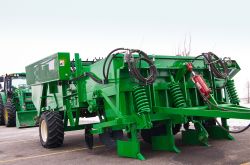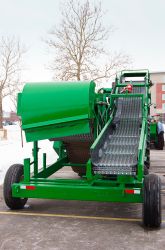 Farmers who are considering growing miscanthus as a bioenergy feedstock now have a tool to make it easier. After years of collaboration and research, a miscanthus rhizome regeneration harvester and planter system has been developed. The unveiling took place during the Bioenergy Feedstocks Symposium held at the University of Illinois (U of I). Typically, miscanthus is a labor-intensive crop requiring multiple machines, and costly manual selection and grading – but not any longer.
Farmers who are considering growing miscanthus as a bioenergy feedstock now have a tool to make it easier. After years of collaboration and research, a miscanthus rhizome regeneration harvester and planter system has been developed. The unveiling took place during the Bioenergy Feedstocks Symposium held at the University of Illinois (U of I). Typically, miscanthus is a labor-intensive crop requiring multiple machines, and costly manual selection and grading – but not any longer.
Timothy Mies, Deputy Director of Operations at the Energy Biosciences Institute at the U of I, said, “When this project started, the propagation of rhizomes was done with shovels and lots of manual labor. These machines will take miscanthus production to a new level.”
The new machine is the result of a three-year collaboration between U of I, Tomax Ltd and Bermuda King USA. According to a news release from U of I, this machinery can lower the cost of miscanthus rhizome production by up to 40 percent and create opportunities for miscanthus to be used more widely as a high-yield bioenergy crop.
 “Bioenergy feedstock processors require security for supply and unless we dealt with regeneration and planting issues for miscanthus, we simply couldn’t make progress,” said Gavin Maxwell, Tomax Ltd Senior Bioenergy Consultant.
“Bioenergy feedstock processors require security for supply and unless we dealt with regeneration and planting issues for miscanthus, we simply couldn’t make progress,” said Gavin Maxwell, Tomax Ltd Senior Bioenergy Consultant.
In recent U.S. trials, the machine has demonstrated a 200 percent increase in rhizome collection over manual systems. this allows, says the research team, the opportunity for regional nurseries to more efficiently expand to meet the demand for both solid and liquid fuel conversion.
So here is how it works. The planter demonstrates a more uniform stream of rhizomes, enabling plant placement at a rate that matches rhizome weight, quality and ground conditions. The four-row planter incorporates separate feed hoppers and placement channels enabling it to be used for both two-row nursery work and larger scale plantations.
In addition, the harvester does bulk lifting of rhizomes on a continual basis with a patented one-pass digging head and oscillating de-soiler. Rhizomes exit via bulk side discharger conveying rootstock to an adjacent trailer. The speed of extraction allows faster transfer of rhizomes to storage which is a real benefit given the seasonal weather restrictions and narrow window of time that may prevail during the rhizome winter dormancy period.
The harvester and planter package will be available beginning this year and will be available for expanded grower crops in time for the 2011 season.

